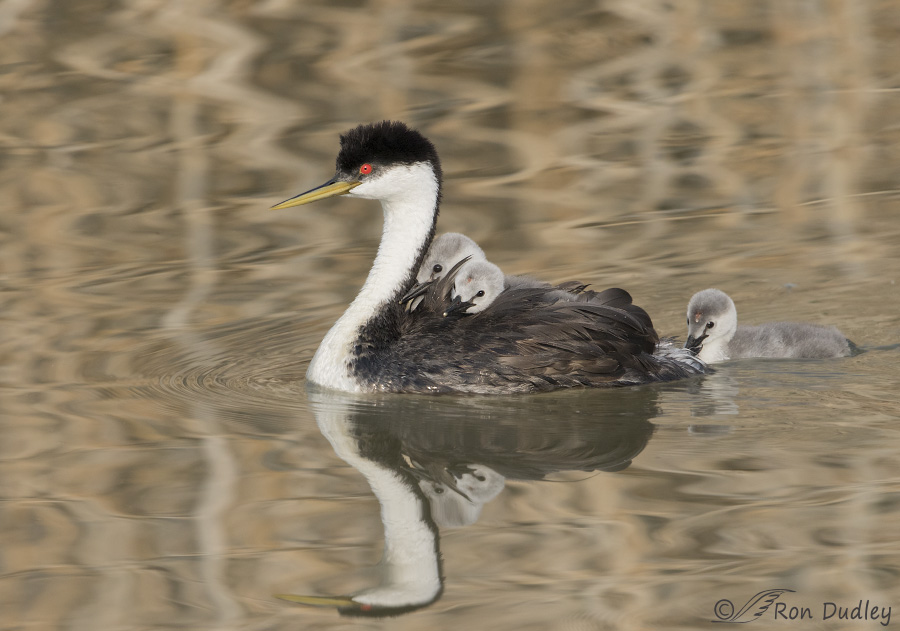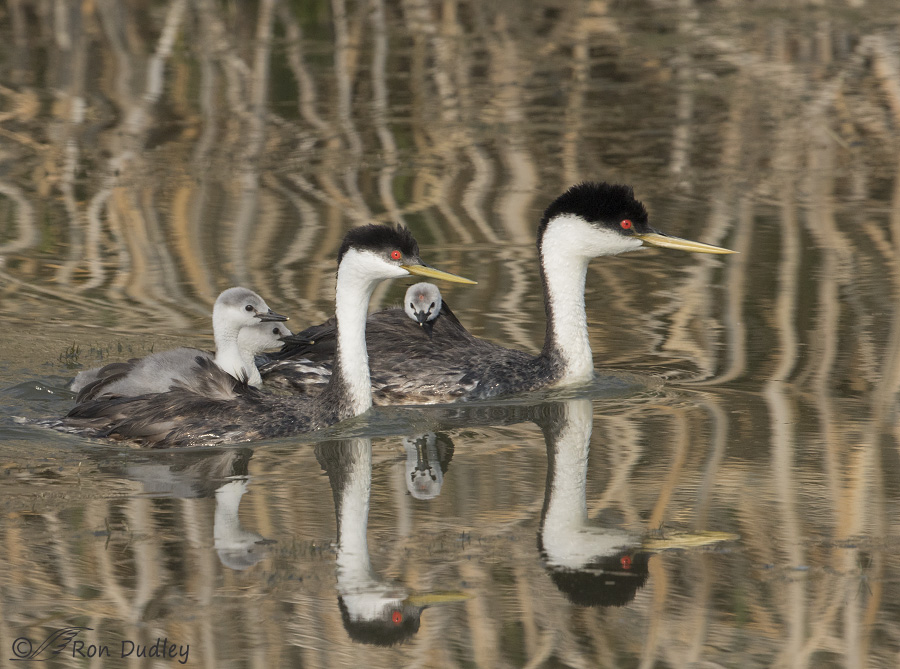When Western Grebe chicks get large enough, back brooding all the siblings becomes problematic.
 1/2500, f/8, ISO 800, Canon 7D Mark II, Canon EF500mm f/4L IS II USM +1.4 tc, not baited, set up or called in
1/2500, f/8, ISO 800, Canon 7D Mark II, Canon EF500mm f/4L IS II USM +1.4 tc, not baited, set up or called in
I photographed this grebe family late last month at Bear River MBR. By this time the chicks were large enough that only two of the three siblings could fit on the back of a parent at the same time so one of them was usually trailing behind an adult and the other two youngsters while the other parent was out fishing. Occasionally the straggler would attempt to climb on board but it would always slide back into the drink.
I’m quite fond of this image because I was able to get at least some light in the eyes of all four birds (a small miracle with the chicks), the crown patch is clearly visible in two of them and I like the reflections on the water of both the background vegetation and the birds.
Eventually the chick that was “hoofin’ it” did find a temporary solution to its problem.

1/1000, f/13, ISO 800, Canon 7D Mark II, Canon EF500mm f/4L IS II USM +1.4 tc, not baited, set up or called in
It simply climbed onto the back of the other parent where it seemed to revel in the fact that it had that taxi all to itself. This didn’t last long though because one of the adults was nearly always out fishing.
In Western Grebes sexes are similar but the female is smaller. That sexual dimorphism is apparent here with the larger adult male on the right.
Ron


Wonderful shots Ron!
Charlotte
Thanks for making me smile, Ron. Wonderful images.
Such sweet pictures. The chicks are cute as can be. Love the reflections!
Thank you, Jean.
I suspect that every parent knows that ‘no room in the taxi’ feeling.
This is a series which softens my anthromorphic heart. Caring, so beautifully expressed.
Thanks very much, EC.
Lovely photos of some of my favorite birds. Having the whole family just made them even better.
Thanks, Marilyn. Yup, a family portrait.
One of the things I like about the first shot is that the reflection makes the adult’s head seem very flat. The reflection sort of matches the way I perceive the heads of Western Grebes. There’s a warmth projected by the back brooding that makes me wish I could just sit and watch these birds for long hours (in actuality I’ve never seen one).
When their triangular crest is erected the top of the head is flat, Susan. Many people don’t even notice that crest, partly because it’s black on black.
Groeat portrait of Kingfisher…love to watch their zoopidty zoop flight…always love weathered wood of old barns and posts, too. Zora image is interesting…bodies and tails seem extra long compared to some of the other water fowl…they make an interesting sound…more like a frog or an insect of some kind….
Thanks, Patty. I’m not sure how this comment posted here instead of yesterday’s post about the kingfisher but I’ll take it either way!
Terrific photographs! I would be overjoyed to get catch light in that many subjects!
I always wonder about a juvenile bird which seems to be “left out” like this one. Will it be weaker than its siblings and less likely to survive or will its seemingly constant struggle make it stronger in the end? I know – I’m ascribing too much “human” type drama to the situation. Too much time on my hands.
I really like the reflection of the habitat on the water. Adds a very nice warm tone to the family portraits.
Thanks, Wally. Watching these birds I had the impression that none of the chicks was a runt or at a physical disadvantage. I believe that each one spent its fair share of time in the water while the others were riding on a parent. I could be wrong though, the individual birds were so much alike that they were difficult to keep track of.
ron, I was at bear river 2 weeks ago and was amazed to find chicks still being fed. I thought this was pretty late in the year to have unfledged chicks – These must be “residents”?? do they have 2 nests. obviously you found the young as well. (good work) I always
admire your work.
Some juveniles are still being fed, even now, at both Bear River and Farmington, Barb. Western Grebes have an extended nesting season. Our grebes are not resident year around although there’s the occasional bird that does stick around through much of the winter if the winter’s not too severe.
Ron, these photos are fabulous! I really love the family interaction that you captured so beautifully. Thank you. The Western Grebe is so cute!!!
Thanks very much, Deborah.
These are such cute scenes…love how proud mom looks in the first and family grouping in the second…size difference in the adults is pronounced and interesting…like the squiggly reflections, too…
Thanks, Patty. I enjoy words like “squiggly”…
Love these images. A great way to start my day looking at your two sweet photos.
I enjoy giving my readers a good start on their day, Ellen – that’s part of the reason that I post early in the morning.
Could this be any cuter? The water looks like moire satin.
“The water looks like moire satin”
Yes, it does, Catherine – particularly in the first image.
Lovely and heartwarming! The patterns of the water are also beautiful.
Thank you, Alison.
REALLY nice photo’s, Ron. It’s always cool to watch the young catching a ride. The Mergansers here do that and when small I’m always amazed how many can hitch a ride. :
I’ve never photographed back brooding mergansers, Judy. I’d love to one day.
Wow. Amazing. Both images are magnificent but the second one is awesome.
The colours, the reflections on the water the pose of all of them, everything is perfect.
Thank you so much for sharing.
I’m glad you like them both so much, Jorge. Thanks for letting me know, partly because I wondered how well the vegetation reflections on the water of the second image would be received – I thought they might be a little busy for some…
The scene on the foreground is so cute and beautiful that any possible dizzyness caused by the background reflections is very remote.